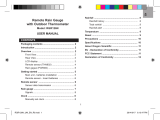
EN
10
• Placement of this product on wood surfaces with
certain types of nishes, such as clear varnish, may
result in damage to the nish. Consult the furniture
manufacturer’s care instructions for direction as to
the types of objects that may safely be placed on
the wood surface. Oregon Scientic shall not be
responsible for any damage to wood surfaces from
contact with this product.
• Do not immerse the unit in water.
• Do not clean the unit with abrasive or corrosive
materials. They may scratch the plastic parts and
corrode the electronic circuit.
• Do not subject the unit to excessive force, shock,
dust, temperature or humidity, which may result in
malfunction, shorter electronic life span, damaged
battery and distorted parts.
• Do not tamper with the unit’s internal components.
Doing so will invalidate the warranty on the unit
and may cause unnecessary damage. The unit
contains no user-serviceable parts.
• Only use fresh batteries as specied in the user’s
manual. Do not mix new and old batteries as the
old ones may leak.
• Oregon Scientic will not be held liable for any
bodily injury, death, property damages, or any
other claims of whatever nature resulting from
the misuse or negligence of the product, whether
intentional or unintentional.
• Oregon Scientic will not be responsible for any
deviations in the usage of the device from those
specied in the user instructions or any or repairs
of the product.
• Placement of this product on wood surfaces with
certain types of nishes, such as clear varnish, may
result in damage to the nish. Consult the furniture
manufacturer’s care instructions for direction as to
the types of objects that may safely be placed on
the wood surface. Oregon Scientic shall not be
responsible for any damage to wood surfaces from
contact with this product.
• Do not dispose this product as unsorted municipal
waste. Collection of such waste separately for
special treatment is necessary.
NOTE Features and accessories will not be available
in all countries. For more information, please contact
your local retailer.






















